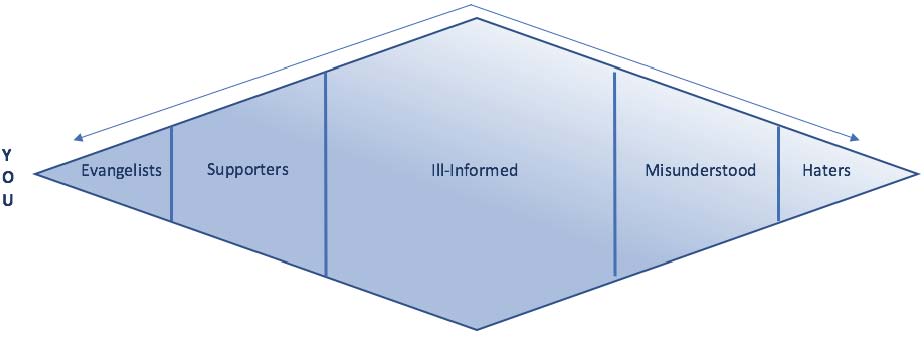There are Six Levels of Influence, and you need to treat each differently.
Here are the levels and how to treat them.
Each week, after Sunday meditation, a group of us head to the local coffee shop to discuss the matters of the day. This week, a member of our group was clearly distraught. She had been watching several YouTube talks about global warming and was afraid that, not only could she do little to really impact the issue, but she feared that we, as a society, are already too late.
She shared that she was going to be buying an electric car, as soon as the new Chevy Bolt came out and that she planned to get solar panels put on her home. She ran the numbers and learned that she could do all this while monetarily breaking even. She also talked about different ways that she could spread the word and generate action by starting different groups … one of which, I suggested they call “Global Warning.”
As I sat there, silently listening to her concerns and plans, my marketing mind whirled and I had an “Aha Moment” about targeting and influence.
Her frustration, in my opinion, is that she wants to change the whole world at once, when maybe she should start thinking a little closer to home with her inner-circle of influencers and work her way out.
The way I see it, there are Six Levels of Influence, whether you are trying to affect climate change or sell more product. And you need to treat each differently.
You
 Whether you’re a parent, a manager at work or someone who wants to change the world, the most effective way to affect other’s behavior is to lead by example.
Whether you’re a parent, a manager at work or someone who wants to change the world, the most effective way to affect other’s behavior is to lead by example.
My friend is buying an electric car and going solar at home. She is walking the walk.
As marketers, we need to think the same way. How can your sales team preach the benefits of your product or service unless they enjoy those benefits firsthand? It is always stronger to say, “This is how the product helped me,” as opposed to, “This is how the product can help you.”
Those Who Think and Act Like You
As we brainstormed about “Global Warning” groups that she could start, it occurred to me that she would be talking, mostly, to those of like-mind and who are motivated to act. In short, targeting this group is preaching to the choir.
Unfortunately, this is also your smallest segment. The upside, is that this group is easy. They require little education and few resources. These would be your very best customers.
Targeted affect: These are your evangelists. They already see the world your way and demonstrate the desired action, so you simply want them to spread the word.
Those Who Think Like You but Don’t Act
You don’t need to convince these folks that you are right, you need to get them motivated to do something. These are your cross-sells. They may have one product, but don’t fully take advantage of all you have to offer.
You can expect to spend a little more resource here, but limited.
Targeted affect: Take action. Buy more product.
Those Who Are Unaware and Ill-Informed of the Issue
As important as your issue is to you, most of the world could care less. When it comes to the issue of our planet, that thought scares the hell out of me. But the truth is, with 7.5 billion people in the world, there are almost as many issues to concern them.
The polar ice caps are melting … plaid lives matter … community banks and credit unions are better options than Chase, Wells Fargo or Bank of America. Regardless of your issue, this will be your largest segment base.
- They need to learn your issue exists
- They need to understand why to care about it – what’s in it for them
- They need to know why your position is the best
For most in this group, the first, loudest and most compelling story will sway them. This is where you need to spend the majority of your resources. These are the people that your “evangelists” need to be talking to. This is where you need to spend your marketing money and time.
This is also where your competition will likely be. You must stand out, be compelling, convincing and repetitive. Again, they really don’t care, so you’ll need to tell them often and be passionate about your story. Never forget, this group can migrate in either direction on the influence meter.
Targeted affect: Awareness. Education. Understanding. Action.
Those Who Disagree with You but Don’t Act
OK, these folks “just don’t get it.” But don’t totally write them off. They may disagree because they never heard your position or there may be a misperception.
These are the folks that don’t believe in global warming because it snowed last winter.
One of the challenges of a world with access to so much information is that we have cherry-picked the information sources that jive best with our preconceived notions. These folks may get all their information from one source.
We’ve all seen the on-the-street interviews of people who are cool with the “Affordable Healthcare Act,” but hate “Obamacare.” There are many people who see Bernie Sanders’ points, but could never vote for a “Socialist,” even if it is a Democratic Socialist. These are simply two of the worst political branding cases in recent history. They are also two cases of ego clouding the understanding of what the public really perceives. The democrats should have ran away from the Obamacare name and Bernie should have dropped the democratic socialist label.
One more example: When I was the VP of Marketing at a credit union, I often heard people say, “I’m not interested in joining a union.”
Don’t hate the “haters.” Talk to them. Find out why they don’t agree with you. You may never change their minds, but understanding their perception can certainly help you to craft a better message in the future.
Targeted affect: You need to understand their perceptions to craft future messages accordingly. If you actually sway one or two, that’s a bonus.
Those Who Actively Work Against You
Let’s face it, we’ll never get everyone to like us. There are some you simply can’t sway. And if they are actively working against you, don’t count on them coming into your camp.
These folks feel strongly against your position and are motivated to act.
Ironically, in business, many in this group may be former customers who feel wronged. The best you can do with them is apologize and try to make things right. Don’t justify … No excuses … Just do your best to make things right and move on.
Aside from that, any time or resources here will be wasted. We’ve all seen the political Facebook battles where no one wins and people only get angry.
Targeted affect: Like the Godfather said, “Keep your friends close, but your enemies closer.” Do your best to understand these folks. What is it that motivates them? What can you do to limit that motivation?
As marketers, or political activists, when we understand the Levels of Influence, we can make better use of our resources and begin to build a strategic plan. We can not change the whole world at one time, but we CAN make a difference, little-by-little … it’s never too late.
Love this Bank & Credit Union marketing blog?
Get the book! Click here to download “Aha Moments,” our
FREE ebook, chock-full of 80 short articles just like this.
In addition to being a strategic consultant for community banks and credit unions, MarketMatch also has nationally and internationally requested speakers. Contact us to bring our marketing ideas to your institution or next conference.
See our story here. (click)
Or email me directly (click)
937-371-2461
Follow us on Twitter @MarketMatch






